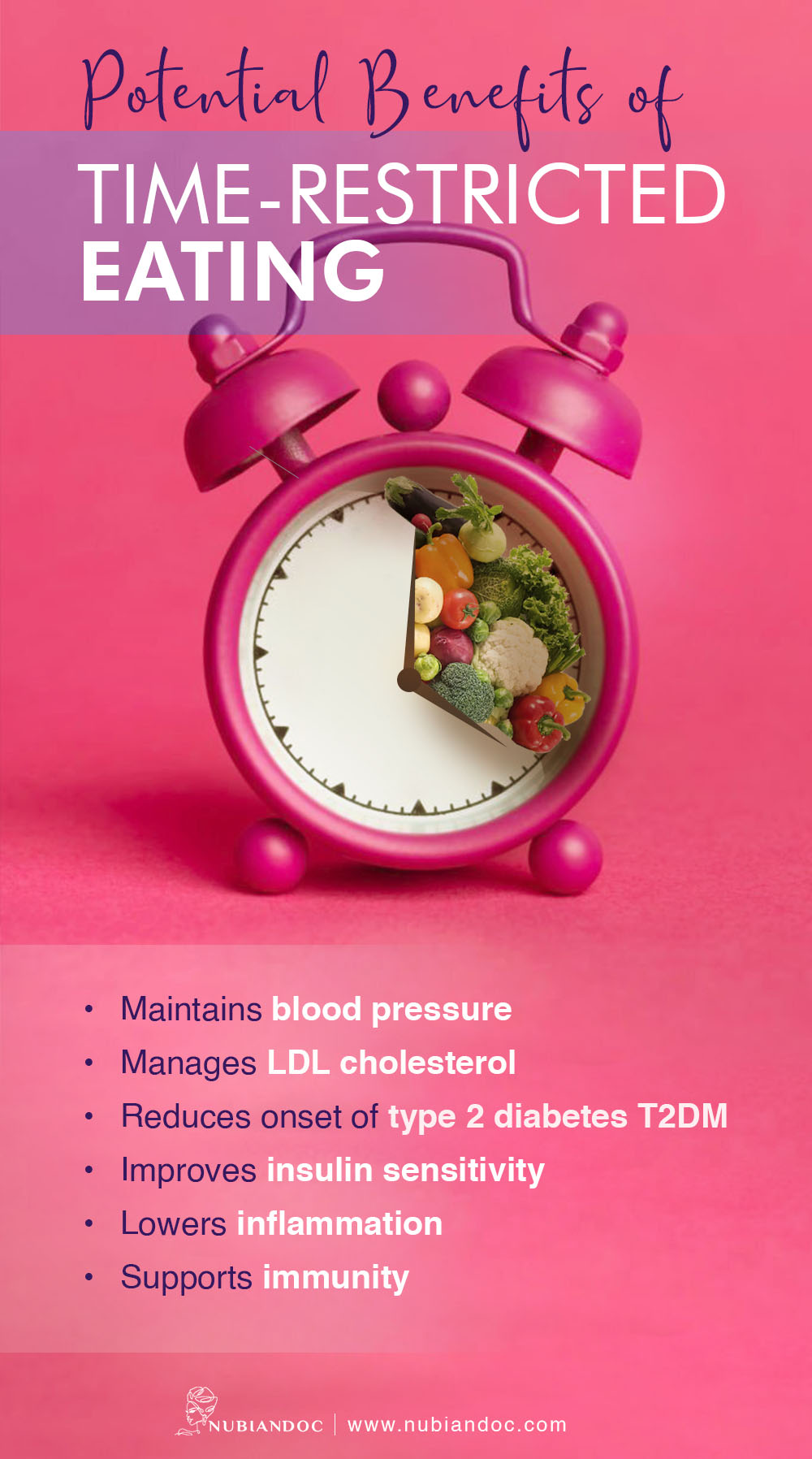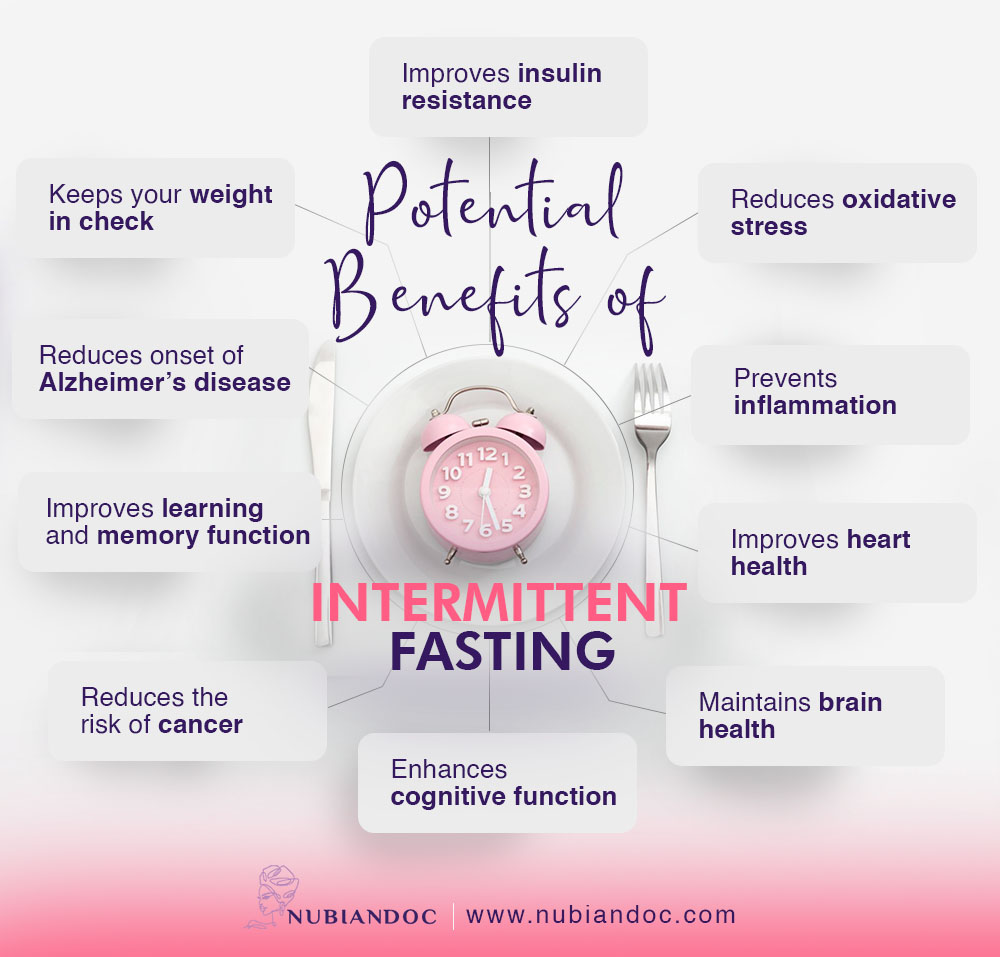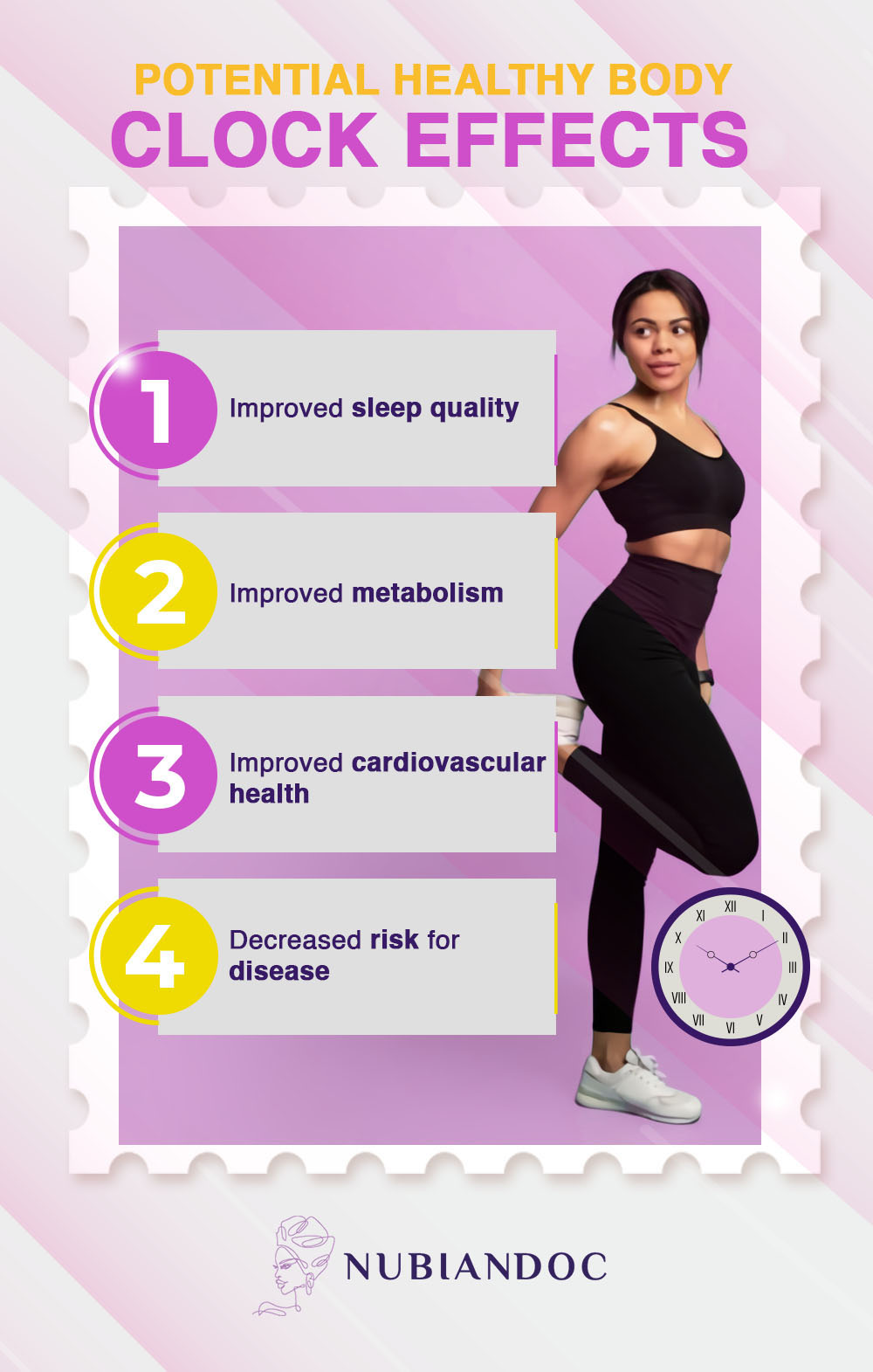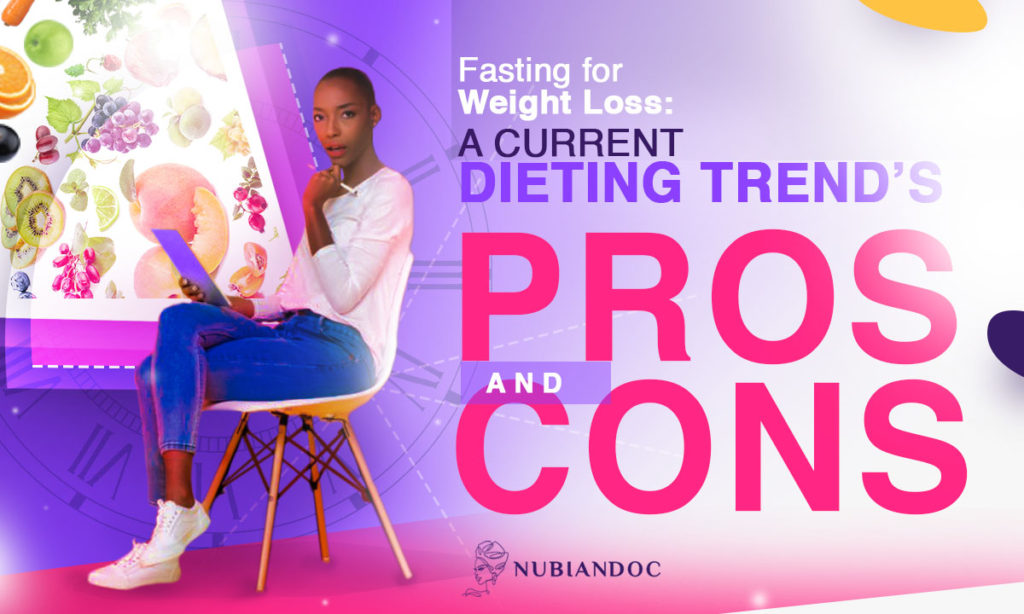Fasting for Weight Loss: Pros & Cons of Intermittent Fasting
Types of Fasting | Intermittent Fasting | Early Time-Restricted Feeding | Late Time-Restricted Feeding | Diet and Nutrition | Benefits l Side Effects
Intermittent fasting (IF) is a trendy weight loss approach. The aim of this diet is to restrict the time period in which you eat food. Unlike most other traditional diets, it’s about limiting when you eat rather than what you eat. Intermittent fasting for weight loss works by prolonging the period when your body has burned through the calories consumed during your last meal and begins burning fat. According to current research, you may experience some benefits of adapting IF such as weight loss, improved metabolic health and a longer life span. However, most of the current literature involves short term studies and a limited number of participants. The research done on longer life span and aging has utilized animal subjects so perhaps has some potential for similar benefit in humans. Intermittent fasting is a broad term types of intermittent fasting include time-restricted feeding, alternate day fasting and periodic fasting.
History of Fasting
Fasting is an ancient practice and most exercised by many cultures and religions for spiritual growth, enlightenment and ritual. In modern times it has application as part of preparation for patients having certain lab testing and surgical procedures. As far as an important therapeutic approach to treating obesity, intermittent fasting has been documented from efforts from 1915. In 1960’s, medical community published an enthusiastic report on it.
In older studies, fasting or “short term starvation periods”, ranged from 1 to 14 days. Later, in 2012, another type of periodic fasting called the 5:2 diet was introduced by Michelle Harvie and Mark Mattson. It was popularized in the UK and Australia by BBC Journalist Michael Mosley after airing of his documentary “Eat, fast and live longer”. This diet involves eating normally 5 days out of the week while the remaining 2 involve significantly limiting calorie consumption to 500 to 600 calories per day.
Summary: Fasting is practiced by many religions including Buddhism, Islam and Christianity. It has shown various health benefits. Intermittent fasting may aid in weight loss and glycemic control and in some individuals. In recent times, fasting, especially intermittent fasting has become a popular dietary weight loss intervention.
Time-Restricted Feeding Vs. Intermittent Fasting
Time restricted feeding (TRF), is a type of intermittent fasting. People who opt for time-restricted feeding typically eat during an 8- to 10- hour, window without restricting caloric intake, and fast during the remaining 14-16 hours. Whereas, in intermittent fasting, people typically eat during an 8- to 12-hour daytime window and fast during the remaining 12 to 16 hours with caloric restriction. People can eat whatever they want if they follow the allotted time restricted feeding pattern.
Summary: Time restricted feeding is different from intermittent fasting because it focuses on the time frame in which you can eat and fast rather than the quantity and quality of calories you are consuming.
Early Time-Restricted Feeding Vs. Late Time-Restricted Feeding
TRF is further classified into two patterns
- Early time-restricted feeding
- Late time-restricted feeding
In the early time restricted feeding (eTRE), you eat during an earlier window of the day between 8am and 5pm whereas in the late time restricted feeding (lTRE), you consume food during the later half of the day between 1pm and 9pm. Both these dietary approaches will result in an 8-h eating period and 16-h fasting period during a 24-h day.
Both of these fasting methods were shown to have metabolic health benefits but research suggests eTRF might be more beneficial. According to a study conducted in 2016 at University of Alabama, eTRF can improve weight loss by reducing daily hunger swings not by increasing calorie burning. Basically, eTRF harmonizes your meals with your circadian rhythm (your body’s internal clock; circadian clock) which promotes homeostasis. It curbs food cravings while improving fat-burning efficiency during sleep.
The potential benefits of eTRF include:
- Reduced cravings and less hunger swings
- Improved fat-burning efficiency, especially during sleep
- Improved metabolic health (the ability to utilize both carbs and fat for energy)
- Potential for significant weight loss
- Potential to increase autophagy and have anti-aging effects
There are other intermittent fasting types such as alternate day fasting and 24 hour fast. Every person has different metabolism, health status, dietary history and medical history so, nutritional counseling is very important. Consult your doctor or nutritionist to check what suits you the best. And as mentioned the data to support much of he research is based on predominantly short term data and a small number of participants.


Summary: Time-restricted feeding is a type of fasting in which you don’t have to care about the amount and type of calories consumed unlike intermittent fasting. Research has shown that, eTRF is more beneficial than lTRF because it adheres with the body’s circadian clock.
Types of Fasting with Schedules |
|
|
Fasting Type |
Schedule |
| 16/8 fasting method | Eat within a period of up to 8 hours and fast for 16 hours |
| 20:4 fasting method | Eat within a 4-hour eating window followed by a 20 hour fast |
| 5:2 fasting diet | Eat normally for five days of the week. But on two non-consecutive days, consume about 500 calories |
| 24-hour fast | Fast for 24 hours once or twice a week |
| 36-hour fast | Fast for an entire day and night, about 36 hours altogether |
Risk Associated with Early Time-Restricted Feeding
It may not be suitable for elderly or underweight persons to start a time restricted feeding regimen. People who have experienced disordered eating should also take caution before restricting eating in any way, including by time of day. Since time-restricted eating does not involve one particular eating schedule, different people might carry it out differently. Setting personal eating times too late in the day could actually cause misalignment with the circadian rhythm. Research suggests that an eating schedule that is misaligned with one’s circadian rhythm can increase a person’s risk for obesity or insulin resistance. Habits like eating bedtime snacks or skipping breakfast are considered misaligned eating.
Summary: Time-restricted eating is not for those who are underweight, pregnant, breastfeeding, young people, or potentially those with certain chronic illnesses. Eating schedules should align with the circadian rhythm in order to avoid complications.


What to Know Before Following Time-Restricted Feeding?
Before following any diet plan, nutrition intervention or any eating plan, always consider consulting a nutritionist or your doctor. Also, take into consideration your current food intake and eating behavior to carefully plan how you can continue to receive the essential nutrients you need following an early time-restricted eating schedule. Adhering to time restricted feeding may be difficult for people who work a late shift or other commitments. Diet and nutrition need to be planned according to convenience.
If your doctor recommends TRF, keep these tips in mind:
- Timing: Although more research is required, experts currently believe that eating between 8 a.m. and 6 p.m. might be the best schedule for those wanting to align with their circadian rhythms.
- Nutrition: Even though restricted eating plans do not specify which foods you should eat, strictly follow the U.S. Department of Agriculture’s (USDA) dietary guidelines, which recommend eating vegetables, fruits, and whole grains every day while restricting added sugar and salt.
- Drinks: Solid foods are not the only things you are avoiding during fasting hours. Sugary or alcoholic drinks count as consumption. Limit your liquids — except for water — to the eating schedule you set.
- Exercise: Following an eating plan alone is not enough to promote good health. If you are able, follow the Center for Disease Control’s (CDC) physical activity guidelines, which call for regular cardio and strength exercises.
- Sleep: Optimal sleep is an integral part of health. Make sure to get adequate quantity and quality. Moreover, If you are desiring to change your eating habits in order to enhance and improve sleep, keep in mind that diet and sleep are connected in ways beyond what time of day you eat. Researchers have also studied foods and drinks that promote sleep.
Summary: Suitable timing for consumption of meals, eating nutrient-rich food, avoiding liquid calories, exercising regularly and having optimal sleep are the most important factors to keep in mind before following a time restricted eating approach.
Dietary Guideline for Beginners
Dietary guidelines for beginners are essential to avoid nutritional deficiency. Some of them are as follows:
- Divide your calorie intake into three main meals and two snacks. Include protein, plenty of vegetables, a handful of quality fiber and healthy fats
- Have your morning meal within two hours of waking up. A healthy and nutritious breakfast consists of key nutrients like protein, fiber, vitamins and healthy fats. One great option is a You can add a ripened banana for creaminess, berries, dark greens like spinach or kale in it
- For night meal, keep it lighter. You can have baked salmon, black bean soup, avocado toast or a salad bowl
- You can have a glass of warm milk before going to bed. It enhances sleep. Tryptophan is an essential amino acid found in milk and other protein-packed foods. It improves sleep and keep you calm
- If you are following time restricted feeding, that doesn’t mean its completely fine to consume unhealthy food and make poor dietary choices. Choose nutrient dense food to fulfil your nutritional needs. Moreover, portion control is still important to keep an eye on
- Cut down caffeine intake as much as possible after noon
- Shut down electronics 30 minutes before going to bed. It helps to improve sleep
- Lastly, try to be more compliant with your routine. The more regular your sleeping and eating habits are, the better your circadian rhythm works
Summary: Dietary guidelines involving maintaining a balanced diet, restricting caffeine are essential to reduce the risk of nutritional deficiencies and promote wellness.
The Bottom Line: Fasting for Weight Loss
Choose your nutrition intervention by keeping in mind your dietary history, medical history, preferences and schedule. Consult a nutritionist to also help you figure out what type is best for you.
While following any diet even if you are fasting for weight loss, you should take care of your daily nutritional needs to avoid food with poor nutritional quality select buying whole, unprocessed and sugar free products to maintain your overall health. Keep your water intake adequate throughout the day.
If your interested in learning further about different health and wellness topics to boost your own physical and mental health, visit NubianDoc. Moreover, Nubian Doc, offers an 8-week meal and exercise plan to help you naturally take control of your eating habits. Visit our website for more details.
Is water allowed during time restricted eating?
Yes, water or no-calorie beverages are allowed to remain hydrated outside of the eating window in time restricted programs ranging from 6- 12 hours.
Do doctors allow intermittent fasting?
Suitability of intermittent fasting varies from person to person. Consult your doctor or nutritionist before following any dietary intervention
Can intermittent fasting reduce weight especially belly fat?
Intermittent fasting is a convenient way to reduce weight without counting calories. Studies do indicate that it may help you lose weight and belly fat.
Who should not do intermittent fasting?
Intermittent fasting is not for everyone. Children and teens under age 18, pregnant and lactating women, people suffering from chronic diseases should avoid this nutrition intervention.



